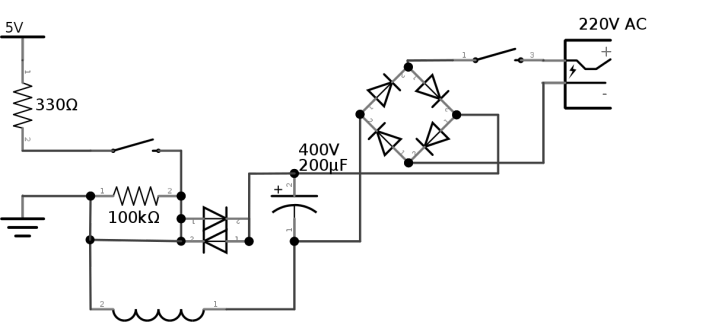Gauss Cannon - written by NiXijav on 2020-02-27

A futuristic sounding but technically simple device. Let's magnetically propel some scrap metal with this!
This project carries certain risks associated with the use of 230 VAC. These voltages are not a toy, and in the worst case it can lead to death. Take the necessary precautions and measures.
Although the title resembles some kind of futuristic or science fiction weapon, a Gauss cannon is actually a very simple device. It is also called ‘coil gun’. Its operation is based on the linear acceleration of a metallic and ferromagnetic projectile thanks to a magnetic field, due to high voltage and intensity provided by a capacitor. In other words, it is a solenoid.
 Magnetic field generated by a solenoid
Magnetic field generated by a solenoid
Here is my circuit:

Broadly speaking, a diode rectifier is used to charge the capacitor, which converts AC to DC. It is important to note that 230V AC ≠230V DC. To calculate the voltage after rectification we can use this simple formula:

RMS means root mean square, or also quadratic mean. To avoid entering long descriptions, click here or here. Applying the formula is:

Finally, VRMS and VAC are added:

Therefore, we need a capacitor of that voltage or more. The chosen one is 400V. Another important thing to note is the use of a thyristor, instead of a normal switch to discharge the capacitor. This is because, in a very short period of time, the capacitor discharges a very large current, and normal pushbuttons or switches cannot withstand such a load. A thyristor can easily withstand 600V at 25A (as used in this circuit). They consist of 3 pins, one input, one output, and one drive. The latter can be triggered by 5V. In my case I used an old 5V charger, but you can also build a power source like this:

Finally, the coil is a simple copper wire wound in an empty tin roll. Ideally, we would have counted the number of turns and the length of the wire, in order to calculate the field strength, but I forgot and did not. In case of having these data, the field strength would be calculated with:

Being μ0 the magnetic permeability, which in the case of air would be 12.56 * 10-7; N the number of turns of the coil, L the length of the copper wire and finally I, the intensity of the current that is passing through the coil. To operate the cannon we will connect it to 230V. The charging time is very short, therefore it is better to put a switch. Once charged, when the second switch is activated, the one coming from the 5V source, the capacitor will discharge very quickly, generating the field in the coil, and also a short noise or zap. The position of the projectile inside the coil is important. The further from the center the projectile is, the faster it will exit and the more space it will travel.
Important note: Never operate the cannon while it is charging, or the diode rectifier will explode. (From own experience)
A good preventive method to avoid operating both at the same time is to put a triple state switch between charger and 5V source. Finishing now, some pictures of the already finished cannon:




No comments yet
Leave a comment